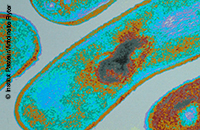

Listeriolysin S: Antibiotic expressed by Listeria monocytogenes
October 2021. Some strains of the bacterium Listeria monocytogenes are capable of producing an antibiotic molecule that enables them to kill other bacteria with which they come into direct contact. This is the case for some particularly virulent strains of the bacterium Listeria monocytogenes which are capable of producing the peptide Listeriolysin S, which has antibiotic properties. However, Listeria monocytogenes does not release the molecule in its environment; it only uses it when it comes into contact with other bacteria. This was revealed by a study conducted by several teams from INRAE, Inserm and the Institut Pasteur, including the Yersinia research unit led by Javier Pizarro-Cerdá, the results of which were published in the journal PNAS.
Targeted action to modulate the composition of the microbiota
In the gut of mammals, Listeria is capable of expressing Listeriolysin S at its surface. The molecule weakens the membrane of some bacterial species with which it comes into contact, causing them to die. "Some of our preliminary results suggest that Listeriolysin S is a very hydrophobic molecule, meaning that it is insoluble in water. If Listeria comes into contact with sensitive bacteria, Listeriolysin S can therefore move directly from the Listeria membrane to the membrane of the sensitive bacteria and does not have to go through the external liquid environment", explains Javier Pizarro-Cerdá. This shows that Listeria is capable of modulating the composition of the gut microbiota so that it faces less competition from other bacteria and is better able to infect the gut and also deep organs like the liver or the spleen. Listeriolysin S is therefore associated with the high virulence of the strains that produce it.
A rare strategy in the bacterial world
The contact-dependent activity of Listeriolysin S is a novel discovery, since it is a rare strategy in the bacterial world. By not releasing the molecule into the environment, Listeria prevents other bacteria from potentially benefiting from the presence of Listeriolysin S. "What's more, adds Javier Pizarro-Cerdá, Listeria will only kill those bacteria that benefit from the same environment and the same resources as it does. It only kills bacteria located close to it, rather than wasting its resources producing a molecule that could go further afield and kill other bacteria."
Reference/s
Meza-Torres J, Lelek M, Quereda JJ, Sachse M, Manina G, Ershov Di, Tinevezh JY, Radoshevich L, Maudet C, Chaze T, Giai Gianetto Q, Matondo M, Lecuit M, Martin-Verstraete I, Zimmer C, Bierne H, Dussurget O, Cossart P, Pizarro-Cerdá J (2021): Listeriolysin S: A bacteriocin from Listeria monocytogenes that induces membrane permeabilization in a contact-dependent manner. PNAS, October 5.
Source: Institut Pasteur
Disclaimer: You agree that B2Bioworld is not responsible and will not be held liable for any third party content on its sites or any third-party content, products or services available on other web sites accessed through links from B2Bioworld sites. Links to third-party sites are for your convenience only, and their inclusion on B2Bioworld\'s sites does not imply any endorsement, guarantee, warranty or representation by B2Bioworld.
Other articles recommended
B2Bioworld offers you background information
Listeria Research Today and Tomorrow
Pascale Cossart, Professor at Institut Pasteur, Paris and Head of Unité des Interactions Bactéries-Cellules
Review: Minute, Tough, and Copious
Science can be fun to read, but be aware. Book Review - open access